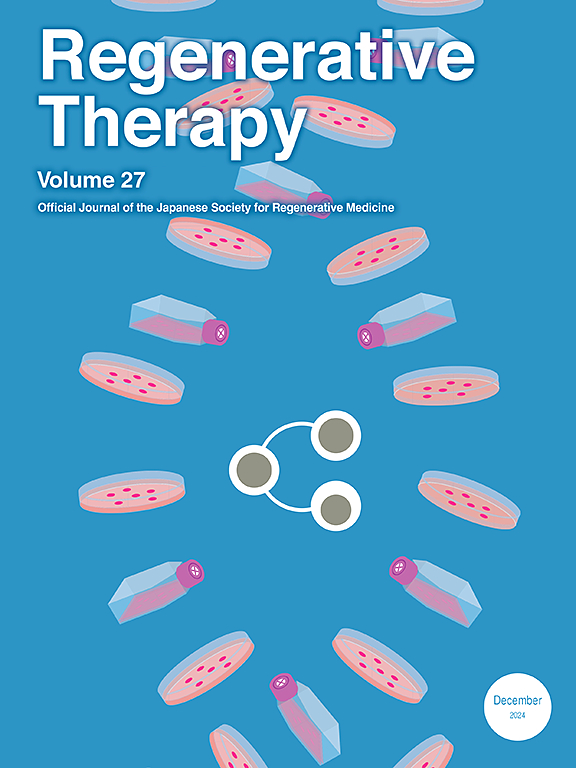Functional analysis of human induced pluripotent stem cell-derived cardiac tissue during endothelial cell network changes
IF 3.5
3区 环境科学与生态学
Q3 CELL & TISSUE ENGINEERING
引用次数: 0
Abstract
Introduction
Tissue structure stability is essential for effective contractile function in cardiac tissue. Although endothelial cells (ECs) serve as critical sources for functional bioengineered cardiac tissue, the process of network changes in ECs affects the cardiac tissue structure. However, how the process precisely influences the synchrony of cardiomyocytes (CMs) contraction and the contraction regularity in the cardiac tissue remains unclear.
Methods
Human induced pluripotent stem cell-derived CMs (hiPSC-CMs) were cultured in well-plates for 9–10 days until they displayed stable spontaneous beating. Human umbilical vein endothelial cells (HUVECs) and normal human dermal fibroblasts (NHDFs), or NHDFs alone, were then seeded and cultured with hiPSC-CMs for 3 days (NHDF + HUVEC + CM, NHDF + CM). Changes in the EC network and cardiac functionality were analyzed over the 3-day period following seeding.
Results
The EC network expanded until day 2, after which it stabilized. The EC network was observed at the layer of hiPSC-CMs on day 3 in NHDF + HUVEC + CM cultures. Motion capture analysis revealed that hiPSC-CMs in NHDF + HUVEC + CM exhibited more synchronous contractions on day 2 than those in NHDF + CM, with no notable differences on days 1 and 3. The irregularity of spontaneous beat rates, measured using cardiac calcium imaging, was significantly higher in NHDF + HUVEC + CM than in NHDF + CM on day 1. However, the irregularity of spontaneous beating in NHDF + HUVEC + CM was more stabilized on day 3 compared with day1. Other parameters, including contraction amplitude, spontaneous beat rate, and calcium uptake and release, did not significantly differ between NHDF + HUVEC + CM and NHDF + CM over time.
Conclusions
Alterations in the EC network may induce irregular spontaneous contractions in hiPSC-CMs at the early phase of co-culture followed by more regular contractions over time, with improving synchrony in the contractions within the cardiac tissue transiently.
内皮细胞网络变化过程中人诱导多能干细胞衍生心脏组织的功能分析
组织结构的稳定性对心脏组织的有效收缩功能至关重要。尽管内皮细胞(ECs)是功能性生物工程心脏组织的重要来源,但内皮细胞网络变化的过程会影响心脏组织结构。然而,该过程如何精确影响心肌细胞(CMs)收缩的同时性和心脏组织的收缩规律尚不清楚。方法人诱导多能干细胞来源的CMs (hiPSC-CMs)在孔板中培养9-10天,使其表现出稳定的自发跳动。然后将人脐静脉内皮细胞(HUVECs)和正常人真皮成纤维细胞(NHDFs)或单独的NHDFs与hiPSC-CMs (NHDF + HUVEC + CM, NHDF + CM)一起接种并培养3天。在播种后的3天内分析EC网络和心脏功能的变化。结果EC网络扩展至第2天,之后趋于稳定。NHDF + HUVEC + CM培养第3天,在hiPSC-CMs层观察到EC网络。运动捕捉分析显示,NHDF + HUVEC + CM的hiPSC-CMs在第2天比NHDF + CM的hiPSC-CMs同步收缩更多,第1天和第3天差异不显著。在第1天,通过心脏钙显像测量的自发心率不规则性,NHDF + HUVEC + CM组明显高于NHDF + CM组。而NHDF + HUVEC + CM自发性心律失常在第3天较第1天更加稳定。NHDF + HUVEC + CM和NHDF + CM之间的其他参数,包括收缩幅度、自发心率、钙摄取和释放,随时间的推移没有显著差异。结论EC网络的改变可能在共培养早期诱导hiPSC-CMs不规则的自发收缩,随着时间的推移收缩更加规律,心脏组织内收缩的同步性暂时改善。
本文章由计算机程序翻译,如有差异,请以英文原文为准。
求助全文
约1分钟内获得全文
求助全文
来源期刊

Regenerative Therapy
Engineering-Biomedical Engineering
CiteScore
6.00
自引率
2.30%
发文量
106
审稿时长
49 days
期刊介绍:
Regenerative Therapy is the official peer-reviewed online journal of the Japanese Society for Regenerative Medicine.
Regenerative Therapy is a multidisciplinary journal that publishes original articles and reviews of basic research, clinical translation, industrial development, and regulatory issues focusing on stem cell biology, tissue engineering, and regenerative medicine.
 求助内容:
求助内容: 应助结果提醒方式:
应助结果提醒方式:


